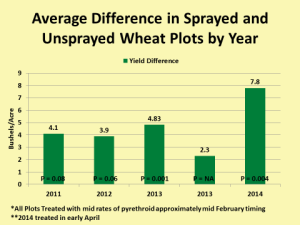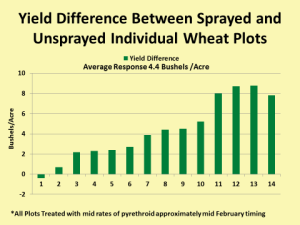Its decision time in wheat. One of the questions we often get is “I am about to apply a herbicide, should I add a pyrethroid?” This is one of the few times I would have to say “Yes” to a question such as this. I think it makes sense to do so. For us to say otherwise in Mississippi would be to completely ignore the data we have generated over the last several years. We waited until we had several years of data and reviewed numerous data sets from Scott Stewart at the University of Tennessee before formerly making this a recommendation. I am very comfortable that the overwhelming data set supports this decision.
Over the last several years we have seen a consistent response in wheat yield when a pyrethroid was used during the late winter months (late January-February). Often when this application goes out it is very difficult to find aphids at any appreciable level; however, they are there, but in very low numbers and generally close to the soil surface due to cold conditions. On average about mid to late March, depending on weather conditions, we see a huge increase in aphid numbers and start getting calls, particularly on acres that have not received an insecticide seed treatment in early planted wheat.
Where we have been testing the late winter pyrethroid application approach we have yet to see aphid populations build later in the spring. Since we know that the residual control of a pyrethroid is not that long, the reason is likely that the aphid populations that blow up in March are from the low numbers that are already present in late winter. In other words, we are likely removing the “seed” aphids while they are at very low numbers and are not getting much subsequent movement back into fields prior to beneficial insect emergence later in the season. Differences in aphid numbers between sprayed and unsprayed plots in late March are often dramatic.
Although we do not see as much Barley yellow dwarf virus (BYDV) in our area, it is here, and this may be what some of the yield differences are attributed to (possibly late asymptomatic infections). However, in some years, BYDV can be observed later in the wheat season after the flag leaf emerges as yellow to purple leaves.
One particular concern I have about this year is the unseasonably length of warm weather in December. While I did not examine a lot of wheat fields in December, I did notice unusually high levels of Bird Cherry-Oat Aphids in oats for this time of year. My concern is that we may have not gotten in front of them this year. This is purely speculation, but again, I have never observed those kind of numbers in December. Another interesting observation from 2014 is that due to the very cold and wet winter, I did not get my pyrethroid out in mid February as planned. It actually went out early April and we still got a 7.8 bushel yield increase. One key observation however is that in 2014 the stage of my wheat and growth and development was similar to conditions normally in mid February. In other words, the calendar did not line up with the season so aphid populations had not yet blown up even though the calendar date was April. Essentially the effect was the same from the pyrethroid application because growing conditions lined up with February and not April.
Below are yield results from four trials I have conducted over the last several years that had sprayed and unsprayed plots in them. Also, here is a link from Dr. Scott Stewart at The University of Tennessee (Click Here) where he has seen the same results in his testing program.
- See more at: http://www.mississippi-crops.com/2015/01/30/pyrethroids-on-wheat-in-mississippi-does-it-pay/#sthash.l6BTjAHr.dpuf
By Angus Catchot, Extension Entomologist, Jeff Gore, Research and Extension Entomologist and Don Cook, Research Entomologist
Its decision time in wheat. One of the questions we often get is “I am about to apply a herbicide, should I add a pyrethroid?” This is one of the few times I would have to say “Yes” to a question such as this. I think it makes sense to do so. For us to say otherwise in Mississippi would be to completely ignore the data we have generated over the last several years. We waited until we had several years of data and reviewed numerous data sets from Scott Stewart at the University of Tennessee before formerly making this a recommendation. I am very comfortable that the overwhelming data set supports this decision.
Over the last several years we have seen a consistent response in wheat yield when a pyrethroid was used during the late winter months (late January-February). Often when this application goes out it is very difficult to find aphids at any appreciable level; however, they are there, but in very low numbers and generally close to the soil surface due to cold conditions. On average about mid to late March, depending on weather conditions, we see a huge increase in aphid numbers and start getting calls, particularly on acres that have not received an insecticide seed treatment in early planted wheat.
Where we have been testing the late winter pyrethroid application approach we have yet to see aphid populations build later in the spring. Since we know that the residual control of a pyrethroid is not that long, the reason is likely that the aphid populations that blow up in March are from the low numbers that are already present in late winter. In other words, we are likely removing the “seed” aphids while they are at very low numbers and are not getting much subsequent movement back into fields prior to beneficial insect emergence later in the season. Differences in aphid numbers between sprayed and unsprayed plots in late March are often dramatic.
Although we do not see as much Barley yellow dwarf virus (BYDV) in our area, it is here, and this may be what some of the yield differences are attributed to (possibly late asymptomatic infections). However, in some years, BYDV can be observed later in the wheat season after the flag leaf emerges as yellow to purple leaves.
One particular concern I have about this year is the unseasonably length of warm weather in December. While I did not examine a lot of wheat fields in December, I did notice unusually high levels of Bird Cherry-Oat Aphids in oats for this time of year. My concern is that we may have not gotten in front of them this year. This is purely speculation, but again, I have never observed those kind of numbers in December. Another interesting observation from 2014 is that due to the very cold and wet winter, I did not get my pyrethroid out in mid February as planned. It actually went out early April and we still got a 7.8 bushel yield increase. One key observation however is that in 2014 the stage of my wheat and growth and development was similar to conditions normally in mid February. In other words, the calendar did not line up with the season so aphid populations had not yet blown up even though the calendar date was April. Essentially the effect was the same from the pyrethroid application because growing conditions lined up with February and not April.
Below are yield results from four trials I have conducted over the last several years that had sprayed and unsprayed plots in them. Also, here is a link from Dr. Scott Stewart at The University of Tennessee where he has seen the same results in his testing program.


Click here to see more...